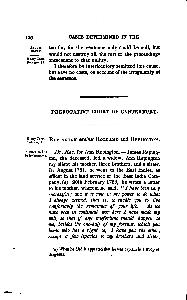
Reports of Cases in the Prerogative Courts of Canterbury p.106

17281 - Oct 1753
1728 |
Born in Chester, Cheshire.1 |
13th May 1728 |
Baptised in St. Oswald, Chester, Cheshire |
15th Dec 1749 |
Wrote will |
Aug 1751 |
Military in Posted to East Indies |
1752 |
Military in Lieutenant of the Troop of Horse, Cavalry |
8th Jan 1752 |
Military in Shipped to Fort St. David, Cuddalore aboard the Durrington |
14th Mar 1752 |
Military in Shipped to Fort St. George, Madras aboard the Durrington |
1753 |
Military in Captain of a troop of Dragoons in the East India Company's service |
Oct 1753 |
Died in East Indies |
|
Married ELIZABETH |
Page created using GEDmill 1.11.0